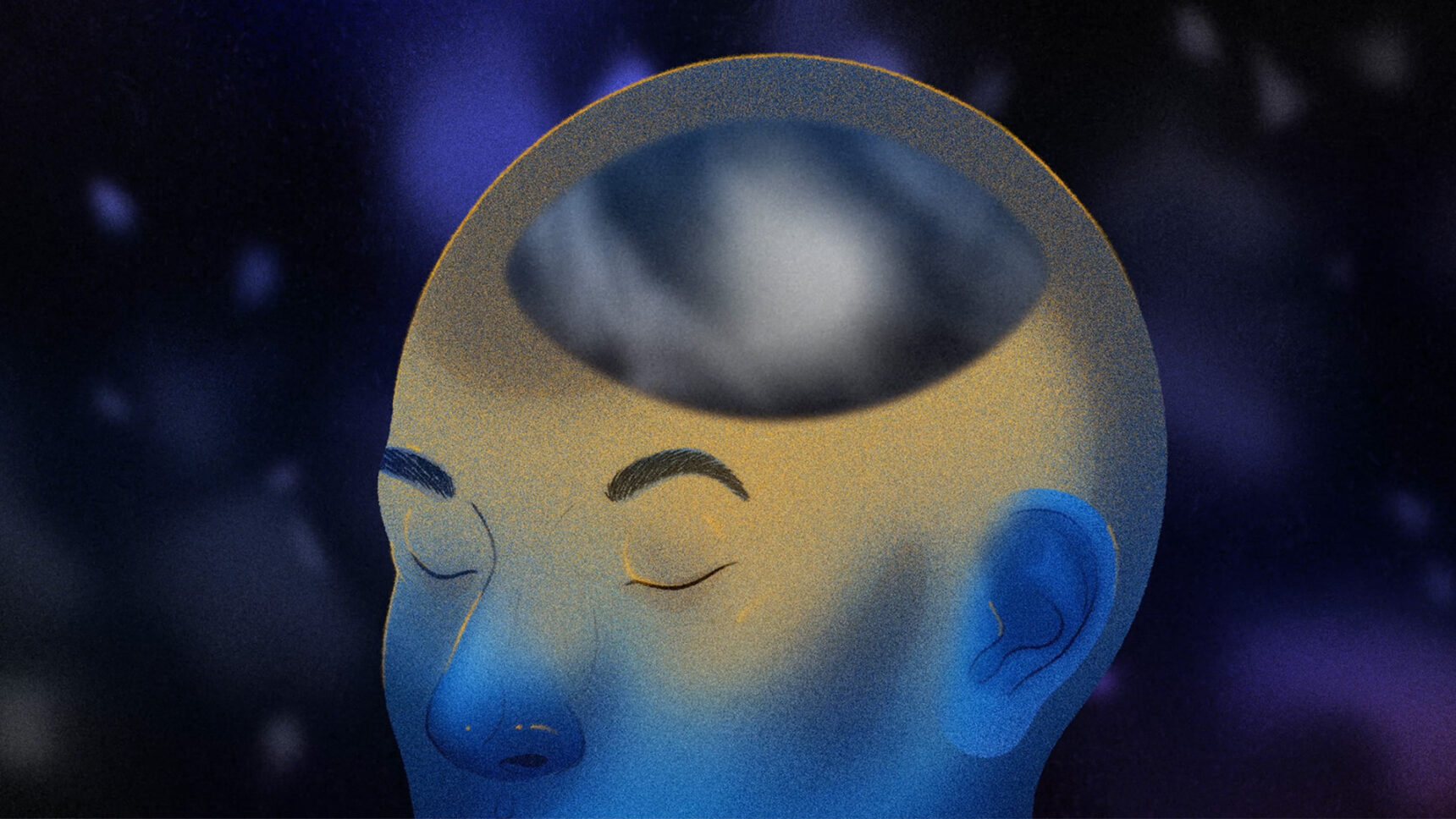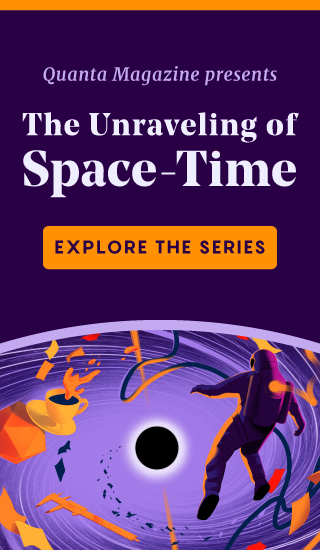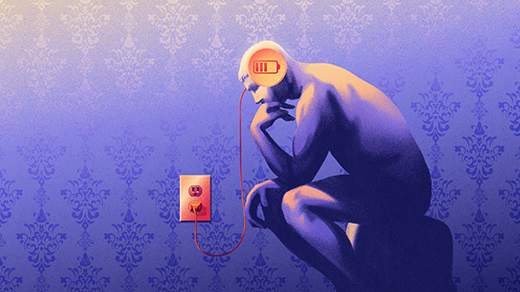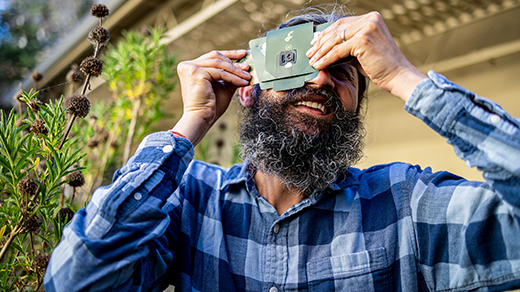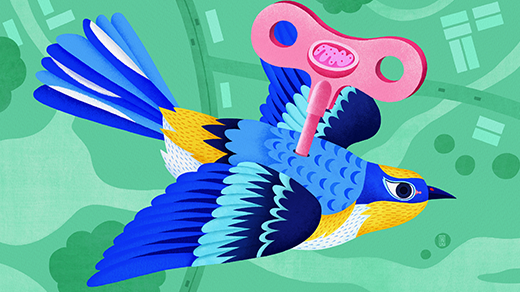What Happens in a Mind That Can’t ‘See’ Mental Images
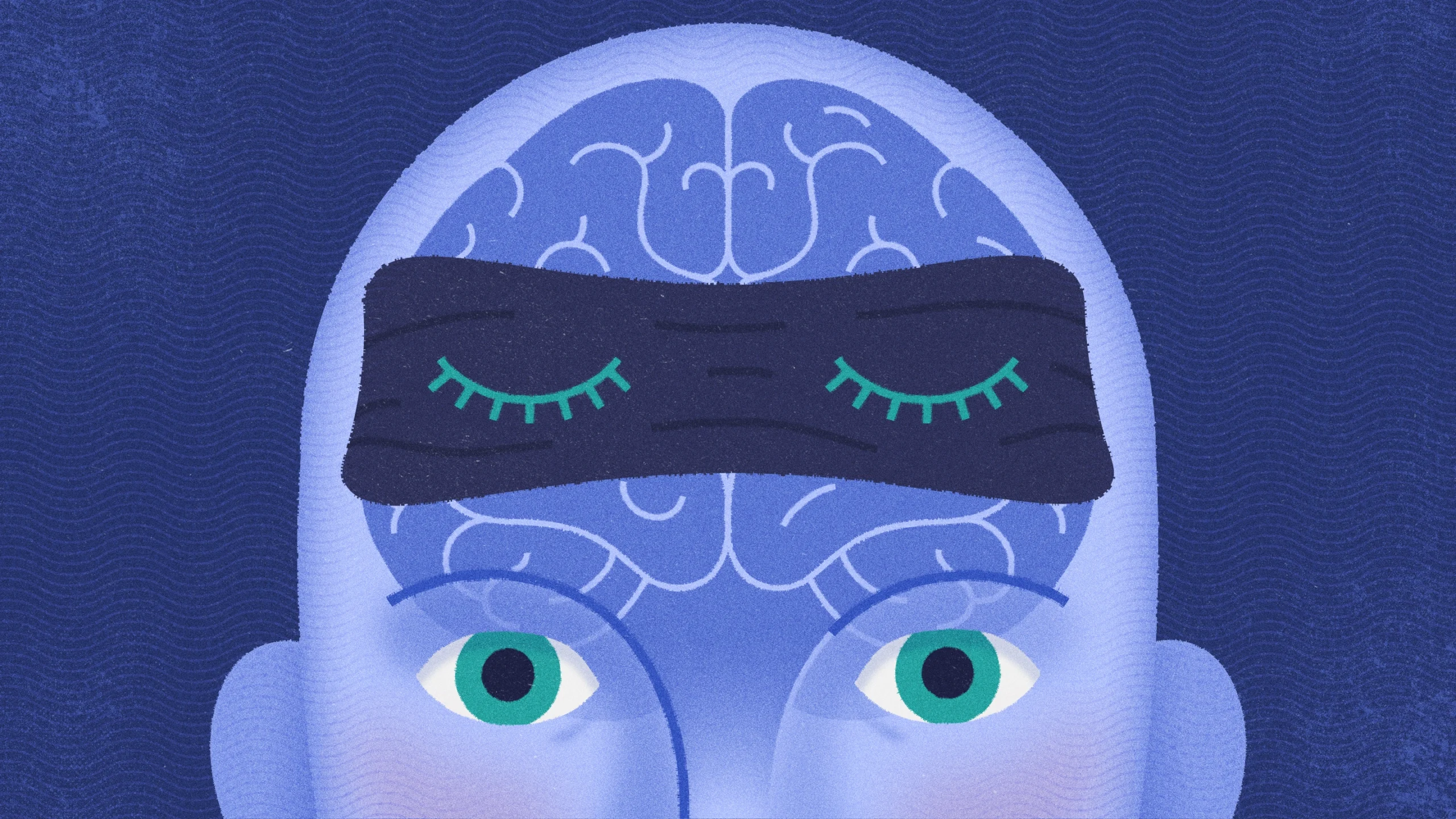
What is imagination in a mind that lacks mental imagery?
Kristina Armitage/Quanta Magazine
Introduction
Two years ago, Sarah Shomstein realized she didn’t have a mind’s eye. The vision scientist was sitting in a seminar room, listening to a scientific talk, when the presenter asked the audience to imagine an apple. Shomstein closed her eyes and did so. Then, the presenter asked the crowd to open their eyes and rate how vividly they saw the apple in their mind.
Saw the apple? Shomstein was confused. She didn’t actually see an apple. She could think about an apple: its taste, its shape, its color, the way light might hit it. But she didn’t see it. Behind her eyes, “it was completely black,” Shomstein recalled. And yet, “I imagined an apple.” Most of her colleagues reacted differently. They reported actually seeing an apple, some vividly and some faintly, floating like a hologram in front of them.
In that moment, Shomstein, who’s spent years researching perception at George Washington University, realized she experienced the world differently than others. She is part of a subset of people — thought to be about 1% to 4% of the general population — who lack mental imagery, a phenomenon known as aphantasia. Though it was described more than 140 years ago, the term “aphantasia” was coined only in 2015. It immediately drew the attention of anyone interested in how the imagination works.

Sarah Shomstein, a perception researcher, was shocked to discover that she lacks mental imagery — a capacity she had never realized she was missing.
Max Ioffe
That included neuroscientists. So far, they’re finding that aphantasia is not a disorder — it’s a different way of experiencing the world. Early studies have suggested that differences in the connections between brain regions involved in vision, memory and decision-making could explain variations in people’s ability to form mental images. Because many people with aphantasia dream in images and can recognize objects and faces, it seems likely that their minds store visual information — they just can’t access it voluntarily or can’t use it to generate the experience of imagery.
That’s just one explanation for aphantasia. In reality, people’s subjective experiences vary dramatically, and it’s possible that different subsets of aphantasics have their own neural explanations. Aphantasia and hyperphantasia, the opposite phenomenon in which people report mental imagery as vivid as reality, are in fact two ends of a spectrum, sandwiching an infinite range of internal experiences between them.
“We think we know what we mean when we talk about what mental imagery is,” said Nadine Dijkstra, a postdoctoral researcher at University College London who studies perception. “But then when you really dig into it, everybody experiences something wildly different.”
That makes studying aphantasia, hyperphantasia and other internal experiences difficult — but far from unimaginable.
The Mind’s Eye
The brain’s process for creating mental images can be described as perception in reverse.
When we perceive something in front of us, “we try to infer meaning from an image,” Dijkstra said. Electromagnetic waves enter our eyes, are translated into neural signals and then flow to the back of the brain, where they’re processed in the visual cortex. The information then flows forward toward the front of the brain into memory or semantic regions — a pipeline that ends with us knowing we are looking at a cat or a cup of coffee.
“During imagination, we basically do the opposite,” Dijkstra said. You start with knowing what you want to imagine, like a cat, and information flows from the brain’s memory and semantic regions to the visual cortex, where the image is sketched. However, that’s a working model of visual imagination; there’s still much that is not known about the process, such as where mental imagery begins and the exact role of the visual cortex.
These processes were even less defined in 2003, when an articulate and bright 60-year-old man walked into Adam Zeman’s office. Zeman, a neurologist at the universities of Edinburgh and Exeter who studies visual imagery, listened as the patient recounted how, following a cardiac procedure, he could no longer conjure mental images. Before, when he read a novel, he could see the characters and the scenes. When he lost something, he could visualize where it might be. After his procedure, his mental stage was empty.
At the time, evidence was accumulating that the visual cortex activates when people imagine or perceive something. Zeman wondered whether his patient’s visual cortex had become somehow deactivated. He had the patient, Jim Campbell, lie down in a functional magnetic resonance imaging (fMRI) machine, which measures blood flow in the brain as a proxy for neural activity. Zeman showed Campbell pictures of famous people and then asked him to imagine them. In the scans, Campbell’s visual cortex lit up only when he saw the photos. In a 2010 case study, Zeman described him as having “blind imagination.”

The neurologist Adam Zeman coined the word “aphantasia” to describe the experience of lacking a mind’s eye. His research suggests that the phenomenon is caused by connection differences in the brain.
Courtesy of Adam Zeman
After Discover magazine covered the case study, Zeman heard from an additional 20 or so people who said that they, like Campbell, couldn’t visualize images in their minds. Unlike Campbell, however, these people hadn’t lost the ability. They never had it in the first place.
Apparently, this was a somewhat common experience. In 2015, Zeman consulted a classicist friend to come up with a name for it. The classicist suggested adapting Aristotle’s word “phantasia,” for “mind’s eye,” to describe the phenomenon, and the term “aphantasia” was born. Soon after Zeman’s team reported the shiny new term, The New York Times published a story about aphantasia, triggering a fresh flood of interest. Zeman has now received more than 17,000 emails from people wanting to learn more about their vivid mind’s eye, or lack thereof.
“Creating the terms turned out to be an unexpectedly good trick to attract a lot of interest,” Zeman said.
At dinner tables around the world, friends and family discussed whether they could imagine an apple. Philosophers used aphantasia as an excuse to probe explanations for the mind. Art exhibitions displayed works created by people with these extremes in visualization.
And scientists dreamed up new ways to study aphantasia as a window into how imagination works.
Making Connections
Studying aphantasia wasn’t easy. How do you measure someone else’s inner reality? For years, research “focused on showing that the condition exists,” Shomstein said.
Early studies relied on reports from participants — and they still do. The most famous test is called the Vividness of Visual Imagery Questionnaire, created in 1973 to study the strength of mental imagery, long before aphantasia was named. However, such tests rely on introspection and self-reported experience, which made some neuroscientists doubt that aphantasia was real. Could reported differences in visual imagery be a language disconnect, given the ambiguity in how we describe our inner worlds?
Mark Belan for Quanta Magazine
“It could be the case that we’re all actually experiencing the exact same apple, we’re just describing it differently,” said Rebecca Keogh, a research fellow in cognitive neuroscience at Macquarie University in Sydney, Australia. In 2015, when Zeman coined “aphantasia,” Keogh was finishing her doctorate under Joel Pearson, a professor of cognitive neuroscience at the University of New South Wales. They were intrigued. The group designed a few tests — one probing the mind’s ability to hold a visual image, and another measuring sweat and pupil responses to mental pictures — to confirm aphantasia’s existence. Their results showed that “it’s not just that they’re reporting a difference,” Keogh said. “There seems to be some sort of difference in their experience.”
To Cornelia McCormick, a memory researcher at the University of Bonn in Germany, the idea that some people don’t have mental images was hard to accept. But then she became curious. Knowing that mental images are intimately tied to memory, she thought, “How on Earth do those people remember their own lives?” To test this, she and her team scanned the brains of people with and without aphantasia while they recalled personal memories.

When the memory researcher Cornelia McCormick first heard of aphantasia, she wondered, “How on Earth do those people remember their own lives?” Her studies found that they tend to have weaker autobiographical memories.
Courtesy of Cornelia McCormick
They found that people with aphantasia indeed tended to have weaker autobiographical memories and less activity in the hippocampus, which helps encode and retrieve such memories. To their surprise, however, the visual cortex had stronger activity among those individuals than in people with more typical visual imagination. McCormick speculated that heightened activity in the visual cortex could inhibit signals needed to pull mental images from the background noise.
A growing number of papers have also found that aphantasics have activity in their visual cortex as they imagine something. Maybe they “have access to the visual information,” said Paolo Bartolomeo, a neurologist at the Paris Brain Institute, “but somehow they cannot integrate this information in a subjective experience.” This hypothesis meshes with the fact that people with aphantasia can recognize objects and faces, and most can see images as they drift off to sleep and in their dreams.
“They know what imagery is like from their dreams,” Zeman said. But for some reason they have trouble accessing this visual information voluntarily. He wondered what was happening in their brains.
A few years ago, Zeman scanned the brains of volunteers as they rested in an fMRI machine. The scans suggested that, at rest, people with aphantasia have weaker connections between the brain’s higher-level control centers (the prefrontal cortex) and its lower-level perception centers (the visual cortex) compared to those with hyperphantasia.
The findings were broadly supported by a recent study from Bartolomeo’s lab, which is currently under peer review. Bartolomeo and his team had participants lie in brain scanners and actively imagine shapes, faces and places. In people with aphantasia and without, similar areas of the brain activated. However, aphantasics showed disconnections between the prefrontal cortex and the fusiform imagery node, a region, identified by Bartolomeo in 2020, involved in higher-level visual processing.
Taken together, the findings suggest that in people with aphantasia, the connections between vision centers and other integrative brain regions differ from those in people without aphantasia. “This is a good claim for some subset of aphantasia,” said Bence Nanay, a professor of philosophical psychology at the University of Antwerp who researches mental imagery. But chances are, he said, there are other neural explanations as well. That would mean that there’s more than one type of aphantasia — and indeed a whole spectrum of internal visualization across different people.
There’s No Normal
People with aphantasia report a variety of experiences. Some can “hear” in their minds, while others can’t imagine either vision or hearing. Some have excellent autobiographical memory, while many do not. Some have involuntary flashes of mental imagery. Most dream in images, but some cannot. Most are born with aphantasia, although a small minority acquire it after injury. “Aphantasia is not a monolithic phenomenon,” Nanay said.
Neither is hyperphantasia. People with hyperphantasia see mental images that seem to them as real as the things they actually see. The images that hyperphantasics see aren’t the same as hallucinations because they know, at the time, that they’re not real. But that doesn’t mean they don’t feel real.
There’s a subset of people with extremely vivid imaginations who are known as maladaptive daydreamers. Some choose to live in their imagination, rather than in real life, Dijkstra said. “They sit down on the couch, they don’t leave their house, they don’t go to school, they don’t see friends, they don’t go to their work. They just imagine their whole life just the way they want it. Because for them, it feels as real as reality.”
No matter how nascent the research is into these imaging extremes, the scientists all agree on one thing: Aphantasia and hyperphantasia are not disorders. People at either extreme of the spectrum don’t have problems navigating the world. Aphantasics are often fine at describing things, Bartolomeo said. When he’s asked them how they can visually describe objects or people from their memories when they lack mental images, they respond: “I just know,” he said.
“It’s just a variant of the normal brain,” he added. “There are variants in everything human.”
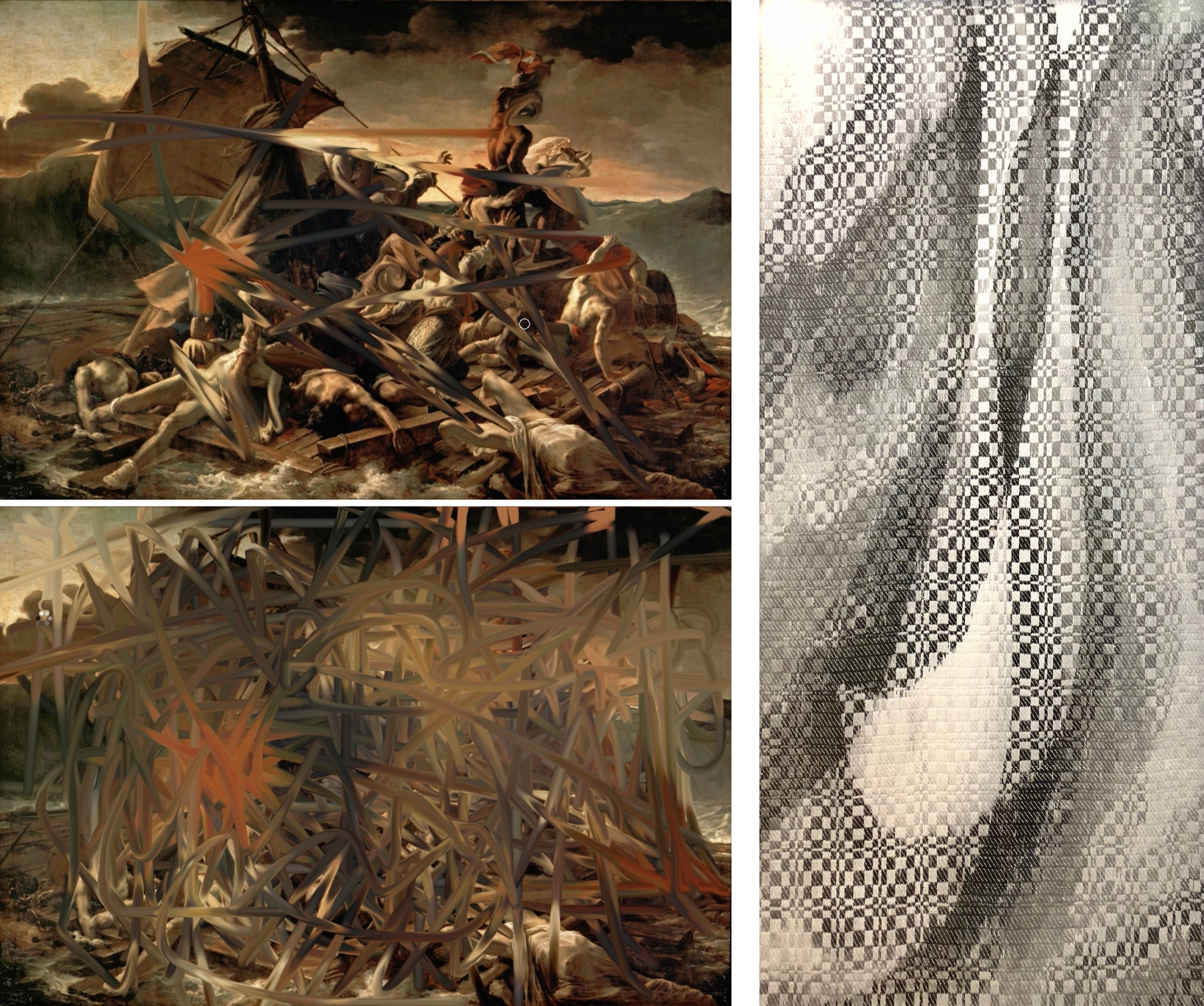
The exhibition Extreme Imagination: Inside the Mind’s Eye featured works by artists with extremes in mental imagery. At left, video stills from Aphantasia – Raft of the Medusa (2017) by Andrew Bracey, who uses “something that exists already, in order to create something new.” At right, Melissa English Campbell, who has hyperphantasia, weaves geometric patterns into linen cloth, such as in Honey (2014), by “spend[ing] hours over days or months composing the whole piece in my mind.”
Left: Stills from Aphantasia (The Raft of the Medusa), Andrew Bracey (2018); Right: Honey, Melissa English Campbell (2014)
Not having mental imagery could even have advantages. “You might think that aphantasia is this terrible thing … a very impoverished mental life,” Nanay said. “[But] I really think that if you have aphantasia, you actually have something to be happy about.” Imagery is often deeply tied with mental health. It’s possible that people with aphantasia are less likely to have mental health problems marked by vivid mental images, he said. On the contrary, if you have hyperphantasia, the risk might increase.
And a lack of mental imagery doesn’t imply a lack of imagination. Zeman has heard from many artists who self-describe as having aphantasia. Shomstein considers herself a creative and imaginative person. Successful people, including the novelist Mark Lawrence and the software engineer Blake Ross, a co-creator of the Firefox web browser, have revealed they have aphantasia.
“It is, I think, as close to an honest-to-goodness revelation as I will ever live in the flesh,” Ross wrote in a 2016 Facebook post about his personal discovery. All his life, he had thought “counting sheep” was a metaphor.
For many people, it can be jarring to find out that they see the world differently than others. Shomstein still can’t believe that other people, with their eyes wide open, can imagine an apricot against the backdrop of the real world. “Wouldn’t [that] interfere with your everyday life?” she said. “I think they’re weird — in a nice way — and they think that I’m weird.”
But really, everybody’s weird, Nanay said. We all sit on the spectrum between hyperphantasia and aphantasia. It’s not only possible but likely that you have a totally different internal experience than someone you walk by on the street.
“The world — as we see it, smell it, hear it, think about it — is reconstructed,” Shomstein said. Even a single shared experience, a thought, a memory, or a simple image of an apple can look and feel shockingly different on the mind’s stage.
So, what do you “see” when you imagine an apple?
